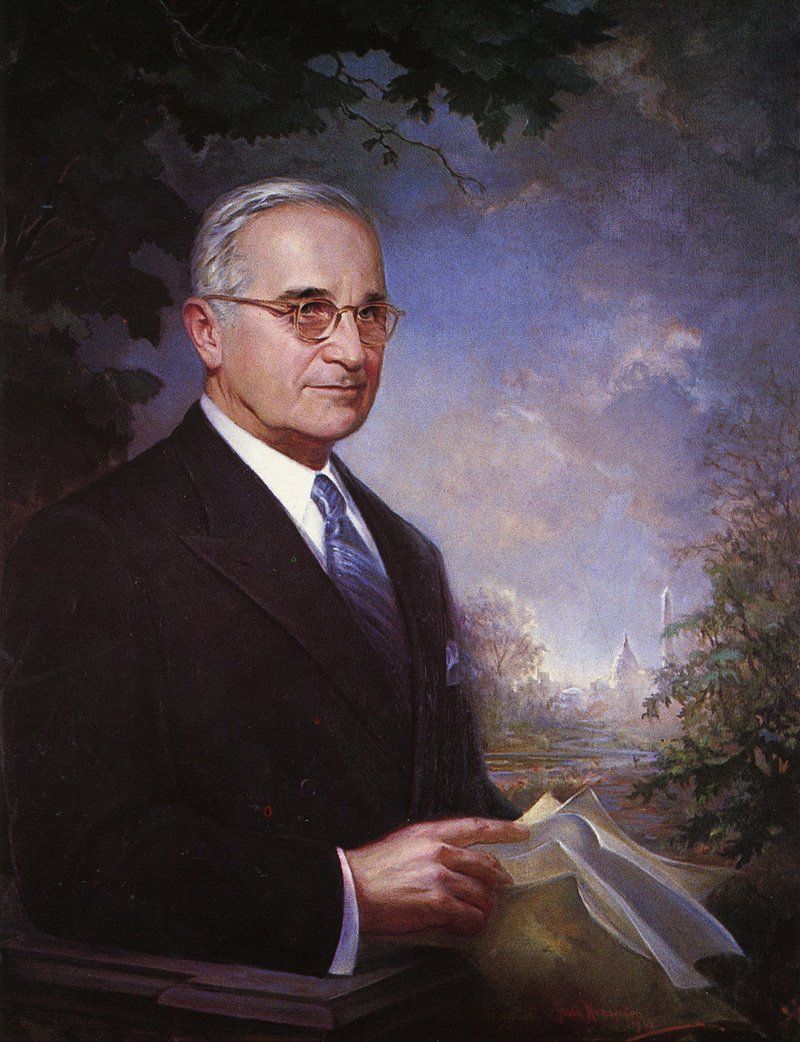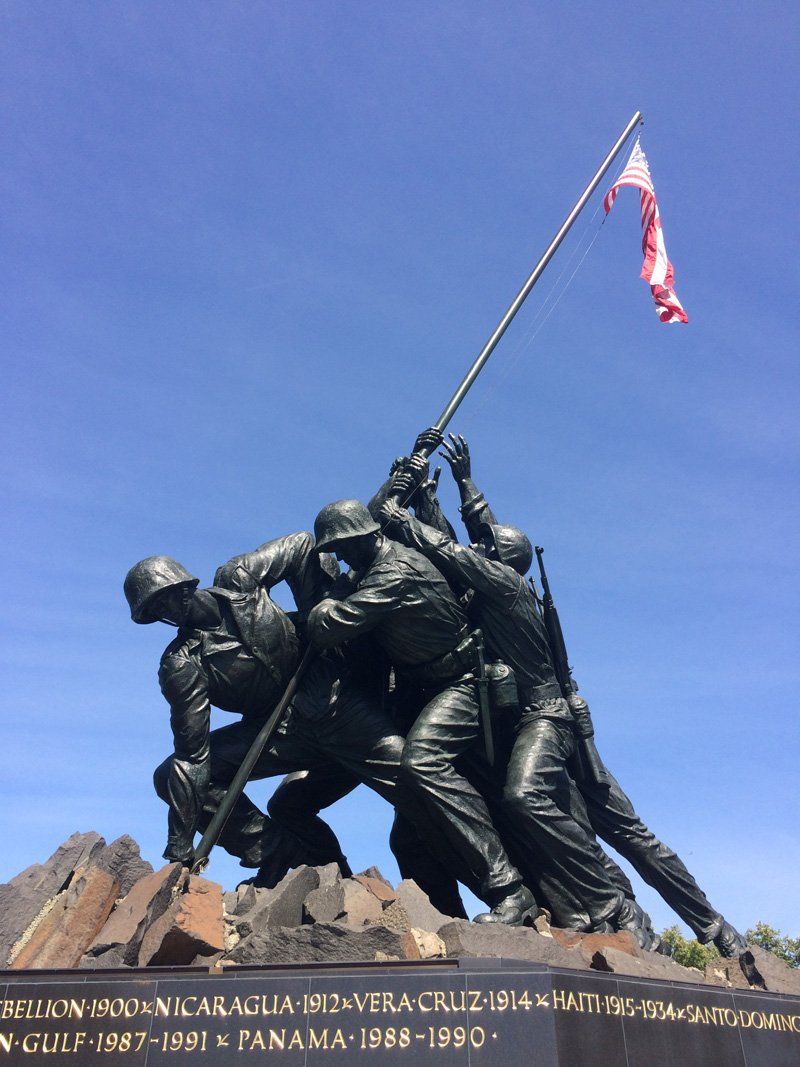Few years were as pivotal to the world as 1945.
It is known to history as the year that World War II ended, but at the beginning of the year peace was not certain.
On January 20, 1945 Franklin D. Roosevelt began his fourth term as President of the United States – the only one was elected for four terms. He would never finish the last one. The private inauguration took place on the South Portico at the White House, because the President was ill. Frances Perkins of his Cabinet recalled that “his face looked thin, his color was gray."1
In spite of his precarious health, Roosevelt met with Soviet leader Joseph Stalin and British Prime Minister Winston Churchill at Yalta, a resort area in the Crimea, for a war summit. The grueling trip further weakened the President, who gave many concessions to the Russian dictator – setting up post-war problems for the West.2
In January 1945 the Battle of the Bulge still raged, though the Allies finally stopped the Nazi advance in the Ardennes, at great cost in human lives. In February in the Pacific, the U.S. fought Japanese troops at the decisive Battle of Iwo Jima. On March 7, U.S. troops crossed the Remagen Bridge into Germany.
On April 1, the United States Army and U.S. Marine Corps invaded Okinawa, one of the southernmost islands of the Japanese archipelago. The Battle of Okinawa lasted nearly three months with excessive casualties. It was the largest amphibious assault of the war, surpassing even the D-Day invasion nearly a year earlier. While it occurred, President Roosevelt died on April 12 at his retreat in Warm Springs, Georgia. A few weeks later, with Allied troops closing in on Germany, Adolph Hitler committed suicide. As the fight on Okinawa continued, Allied victory was declared in Europe on May 8. The United States no longer had to fight the immense and disastrous war on two fronts. Japan, however, resisted at every turn and the casualty counts grew exponentially.
The U.S. successfully invaded Okinawa, with a plan to use the island to launch an invasion of Japan. Harry Truman, the new President, knew the deaths for America would be staggering for such an engagement. Having been kept in the dark by Roosevelt, Truman began to ask for other options.
On July 30, the U.S.S. Indiana
sank in the Pacific near the Philippine Islands, having been struck by a torpedo. The survivors remained in the sea for days. Hundreds died while awaiting rescue, many of them victims of shark attack. The American populace was horrified by the news in the seemingly never-ending war.3
A week later, on August 6, 1945, President Truman ordered that a new weapon, an atomic bomb, be dropped on the Japanese city of Hiroshima. The effects were widespread and devastating. When Emperor Hirohito still refused to surrender, another bomb was dropped a few days later on the city of Nagasaki. Five days later, the Japanese surrendered. On September 2, World War II officially ended. Tens of millions had perished in that war. Repercussions, though, were just beginning for the surviving perpetrators.
Trials of Nazi leaders began at Nuremberg, and from those trials came information of the Nazis’ mass extermination plans for Jews and others who did not fit their idea of worthiness to share the planet. By the holiday season, newspapers alerted the people in America of the atrocities. A December 14th headline for The Gettysburg Times
recounted: “Secret Police Records Reveal 6 Million Jews Slain by Nazis.” In the following article, recorded from the Nuremberg trial, Himmler testified that the number was actually much higher in their many “extermination camps.”4
As the weather cooled in December, news of a new war, a Cold War with the Soviet Union, first emerged. Soldiers also began returning from Europe and the Pacific, and their tales of horror from the battlefield and from prison camps were published.
On December 19, 1945 Gettysburg and Adams County were blanketed in “the heaviest snow of the year.” Accidents abounded, and residents were urged to stay home and to take care when driving. The holiday season was a healthy one for the economy as veterans began to arrive home for Christmas – and were at home to stay.5
On Christmas Eve, 1945, a record of three degrees below zero was set, making “white Christmas a certainty for Gettysburg”. On that day, the burial of General George Patton at the American Military Cemetery in Luxembourg took place. Taps
was played over his grave, a final tribute to the losses of that year.6
Seventy-five years ago, the world experienced a most pivotal year. A terrible war had ended and the nations of the earth were grateful. A war-torn Europe suffered greatly, but America already began to reach out and help. In the following seven and a half decades, there were more wars, additional unrest and continuing atrocities all over the world. But in December 1945, there seemed to be, for a time, peace on earth.
The Marine Memorial, depicting a heroic scene from Iwo Jima
(Author photo)
Sources: Baer, Brett. Three Days at the Brink: FDR’s Gamble to Win World War II. New York: HarperCollins, 2019. The Gettysburg Times, 14 Dec., 1945. The Gettysburg Times, 19 Dec., 1945. The Gettysburg Times, 24 Dec., 1945. Grun, Bernard. The Timetables of History. New York: Simon & Schuster, 1991.
End Notes:
1. Baer, p. 345.
2. Ibid, p. 356-358. Among the deals made at Yalta, FDR promised Stalin control in Germany and much of eastern Europe, and the two nations agreed to divide Korea into two parts, North and South Korea, which so remain to this day.
3. Grun, p. 522.
4. Gettysburg Times, 14 Dec., 1945.
5. Gettysburg Times, 19 Dec., 1945.
6. Gettysburg Times, 24 Dec., 1945. The general had been in an auto accident on December 9 and succumbed to his injuries on December 21.





